Fair Isaac Bundle
Who Does Fair Isaac Company Serve?
Delving into the Fair Isaac SWOT Analysis reveals the critical importance of understanding the customer demographics and target market for Fair Isaac Company (FICO). From its inception, FICO has navigated the evolving landscape of financial services, adapting to the increasing reliance on data-driven decisions. This journey highlights the need to identify who FICO's customers are and how their needs have shaped the company's growth.
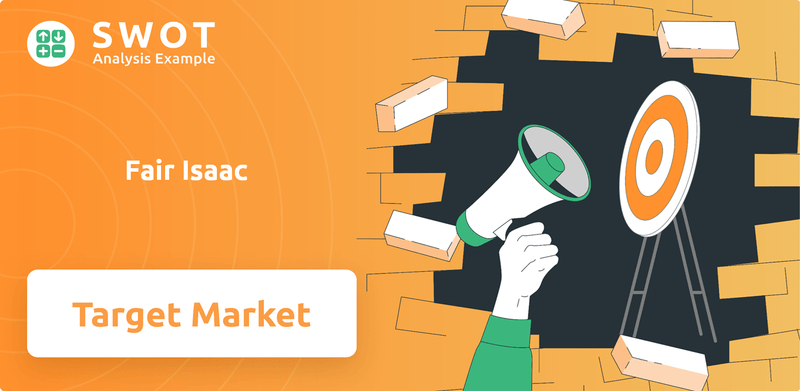
Understanding the target market is essential for FICO's strategic planning, from credit scoring to fraud detection. Examining the customer demographics provides insights into the age range of FICO users, their income levels, and geographic distribution. By analyzing FICO's ideal customer and customer behavior, we can better understand how FICO identifies its target market and its market strategy, including customer acquisition and the industries that use FICO, including small businesses.
Who Are Fair Isaac’s Main Customers?
Understanding the primary customer segments of the Fair Isaac Company, or FICO, is crucial for grasping its market position. FICO primarily operates in the business-to-business (B2B) sector. Its core customer base consists of financial institutions and other businesses that rely on its analytical tools and services.
The target market for FICO is largely defined by the need for robust risk management, fraud detection, and customer lifecycle management solutions. These are essential for institutions dealing with large volumes of consumer data. The company's offerings are designed to provide actionable insights, helping clients make informed decisions and mitigate financial risks.
While FICO doesn't directly serve individual consumers, its impact on consumer finance is significant. The FICO Score is a fundamental component of credit decisions in the United States and globally. This indirect influence highlights the company's broad reach and importance in the financial ecosystem.
Banks, credit unions, and mortgage lenders are key customers. They use FICO's solutions for credit scoring, risk assessment, and fraud prevention. These institutions depend on FICO's analytics to manage their portfolios and make informed lending decisions. In 2024, the financial services sector accounted for a substantial portion of FICO's revenue, reflecting its continued reliance on this segment.
The automotive industry utilizes FICO's solutions for assessing creditworthiness and managing customer relationships. With the rise of auto loans and leasing, accurate risk assessment is critical. The automotive sector's adoption of FICO's services has grown steadily, driven by the need for data-driven decision-making in financing and sales.
Retailers employ FICO's tools for fraud detection and customer analytics. As e-commerce and online transactions increase, the need to protect against fraud becomes more important. FICO's solutions help retailers identify and prevent fraudulent activities, ensuring secure transactions and protecting their bottom lines. The retail sector's investment in fraud prevention technologies has increased, aligning with FICO's strategic focus.
Healthcare providers and telecommunications companies use FICO's solutions for risk assessment, fraud detection, and customer insights. These sectors deal with vast amounts of sensitive data, making data security and accurate risk assessment essential. The adoption of FICO's solutions in these sectors underscores the company's ability to provide value across various industries.
FICO's B2B customers require scalable and secure analytical platforms capable of processing large datasets. They often operate in regulated environments, necessitating solutions that ensure compliance and mitigate financial risk. The company's focus on enterprise-level software and fraud detection solutions reflects these needs.
- Scalability and Security: Customers need platforms that can handle growing data volumes securely.
- Compliance: Solutions must meet regulatory requirements in various industries.
- Actionable Insights: Customers seek tools that provide clear, data-driven decision support.
- Fraud Prevention: Strong fraud detection capabilities are essential to protect against financial losses.
Fair Isaac SWOT Analysis
- Complete SWOT Breakdown
- Fully Customizable
- Editable in Excel & Word
- Professional Formatting
- Investor-Ready Format
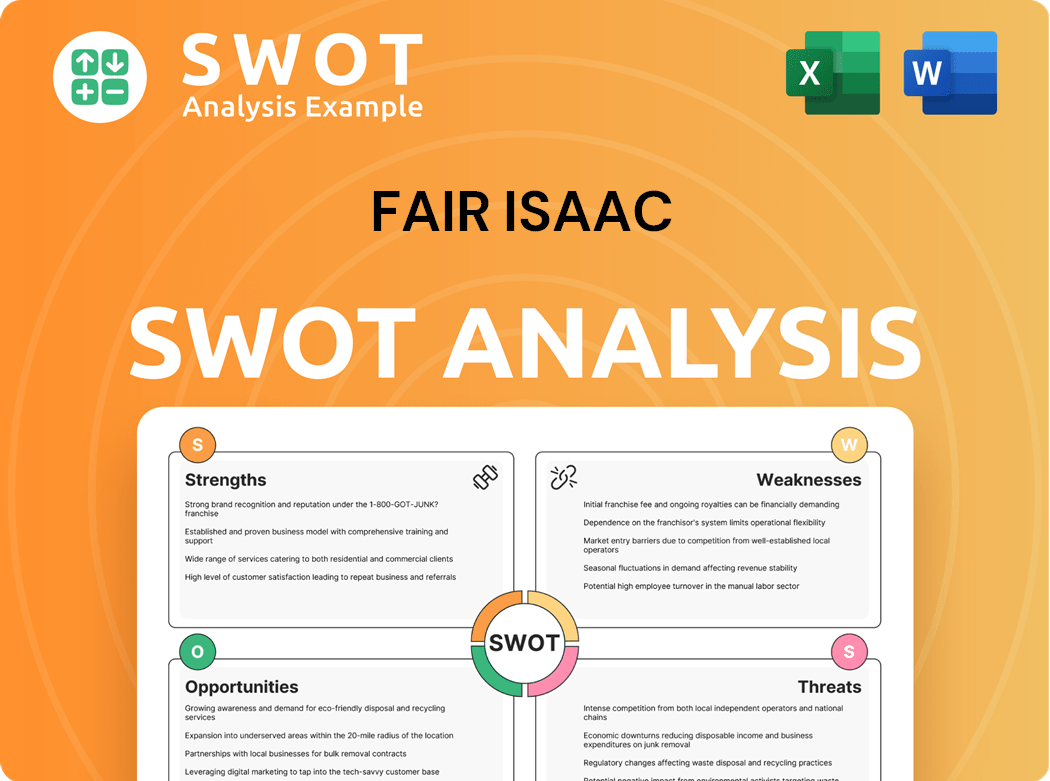
What Do Fair Isaac’s Customers Want?
Understanding the customer needs and preferences is crucial for the success of any business, and the same holds true for the Fair Isaac Company, also known as FICO. FICO's customers are primarily driven by the need for accurate risk assessment, fraud prevention, operational efficiency, and an improved customer experience. These needs shape their purchasing behaviors and influence their decision-making processes.
Financial institutions, for instance, are major consumers of FICO's products and services. They prioritize solutions that enable precise lending decisions, minimize default rates, and ensure compliance with regulatory requirements. The demand for reliable, scalable, and integrated analytical platforms is a key factor in their buying decisions. These platforms need to seamlessly integrate into their existing infrastructure to provide maximum value.
The decision-making criteria for FICO's customers often include the proven accuracy of its models, the breadth of its analytical capabilities, and its reputation for data security and compliance. Customers also look for solutions that offer flexibility and customization to address their unique business challenges. For example, FICO's fraud detection solutions are tailored to combat specific types of fraud prevalent in different industries.
The psychological drivers for choosing FICO's offerings include the assurance of mitigating financial risk and the confidence in making data-driven decisions. Practical drivers include the ability to automate processes, reduce manual errors, and improve overall operational efficiency. The customer base spans various industries, including banking, insurance, and retail, each with specific needs.
- Risk Mitigation: Customers need solutions that accurately assess and mitigate financial risks, such as credit risk and fraud.
- Operational Efficiency: Automation and streamlined processes are essential to reduce manual errors and improve overall efficiency.
- Data-Driven Decisions: Customers seek solutions that provide reliable data and insights to support informed decision-making.
- Compliance: Adherence to regulatory requirements and data security standards is a top priority.
- Customization: Solutions must be flexible and adaptable to address unique business challenges and industry-specific needs.
Common pain points that FICO addresses include the complexity of managing large datasets, the challenge of detecting sophisticated fraud patterns, and the need to personalize customer interactions at scale. FICO tackles these challenges by offering advanced analytics, machine learning capabilities, and decision management platforms. The company's product development roadmap is significantly influenced by customer feedback and market trends, such as the increasing demand for real-time analytics and artificial intelligence. For example, FICO has invested in developing AI-powered solutions to enhance fraud detection and credit risk management. For a deeper dive into how FICO operates, consider exploring the Revenue Streams & Business Model of Fair Isaac.
Fair Isaac PESTLE Analysis
- Covers All 6 PESTLE Categories
- No Research Needed – Save Hours of Work
- Built by Experts, Trusted by Consultants
- Instant Download, Ready to Use
- 100% Editable, Fully Customizable
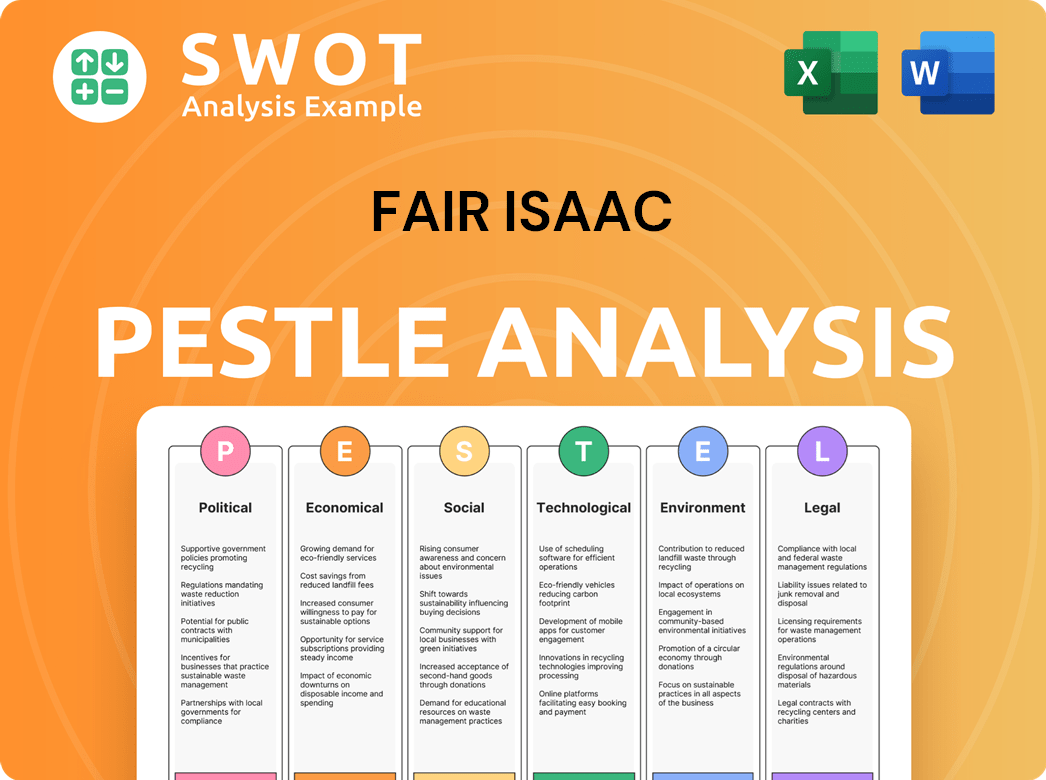
Where does Fair Isaac operate?
The geographical market presence of the company is extensive, with a significant global footprint. Its operations and customer base are spread across North America, Europe, Asia-Pacific, Latin America, and Africa. This broad reach allows the company to serve a diverse range of clients and adapt to varying regional needs.
The United States remains the largest market for the company, where its credit scoring solutions are the industry standard. In Europe, the company has a strong presence, especially in the UK, Germany, and France, where its fraud and compliance solutions are highly valued. The Asia-Pacific region is a growing market, driven by increasing financial inclusion and digital lending adoption.
The company customizes its offerings to fit regional regulatory frameworks and data availability. This includes developing region-specific credit scoring models that consider local economic conditions and consumer behaviors. This localization strategy helps the company maintain its competitive edge and meet the specific needs of its diverse customer base. To understand more about the business, you can review the Growth Strategy of Fair Isaac.
The United States is the primary market, with the FICO Score being the industry standard for credit risk assessment. The company holds the strongest market share and brand recognition in this region. Customer demographics in North America are diverse, with varying income levels and credit behaviors.
The company has a strong presence, particularly in the UK, Germany, and France. Financial institutions in Europe highly value its fraud and compliance solutions. The target market includes banks, credit card issuers, and other financial service providers.
This region, including India, China, and Australia, represents a growing market. The expansion is driven by increasing financial inclusion and the adoption of digital lending. The company tailors its solutions to meet the specific needs of these markets.
These regions are emerging markets with significant growth potential. The focus is on solutions that enable financial inclusion and address limited credit history challenges. The company partners with local entities to ensure market penetration.
The company's diversified global revenue stream reflects its widespread market penetration. While specific sales distribution percentages by region for 2024-2025 are proprietary, the company's annual reports consistently highlight this diversification.
The company localizes its offerings by adapting its scoring models and analytical tools to specific regional regulatory frameworks and data availability. This includes developing region-specific credit scoring models that account for local economic conditions and consumer behaviors.
Strategic expansions often involve partnerships with local financial institutions and technology providers. These partnerships ensure market penetration and cultural relevance, helping the company reach a broader audience and tailor its offerings.
Differences in customer demographics, preferences, and buying power across regions necessitate tailored approaches. In emerging markets, there's a greater emphasis on solutions that enable financial inclusion. In developed markets, the focus is on advanced analytics for personalized customer engagement and fraud prevention.
The Asia-Pacific region is a significant growth area, driven by financial inclusion and digital lending. The company is adapting its strategies to meet the specific needs of countries like India and China, which are experiencing rapid financial growth.
In Europe and North America, the demand for fraud and compliance solutions remains high. The company's ability to provide advanced analytics for fraud prevention is a key driver of its success in these markets. This is particularly important for financial institutions.
Fair Isaac Business Model Canvas
- Complete 9-Block Business Model Canvas
- Effortlessly Communicate Your Business Strategy
- Investor-Ready BMC Format
- 100% Editable and Customizable
- Clear and Structured Layout
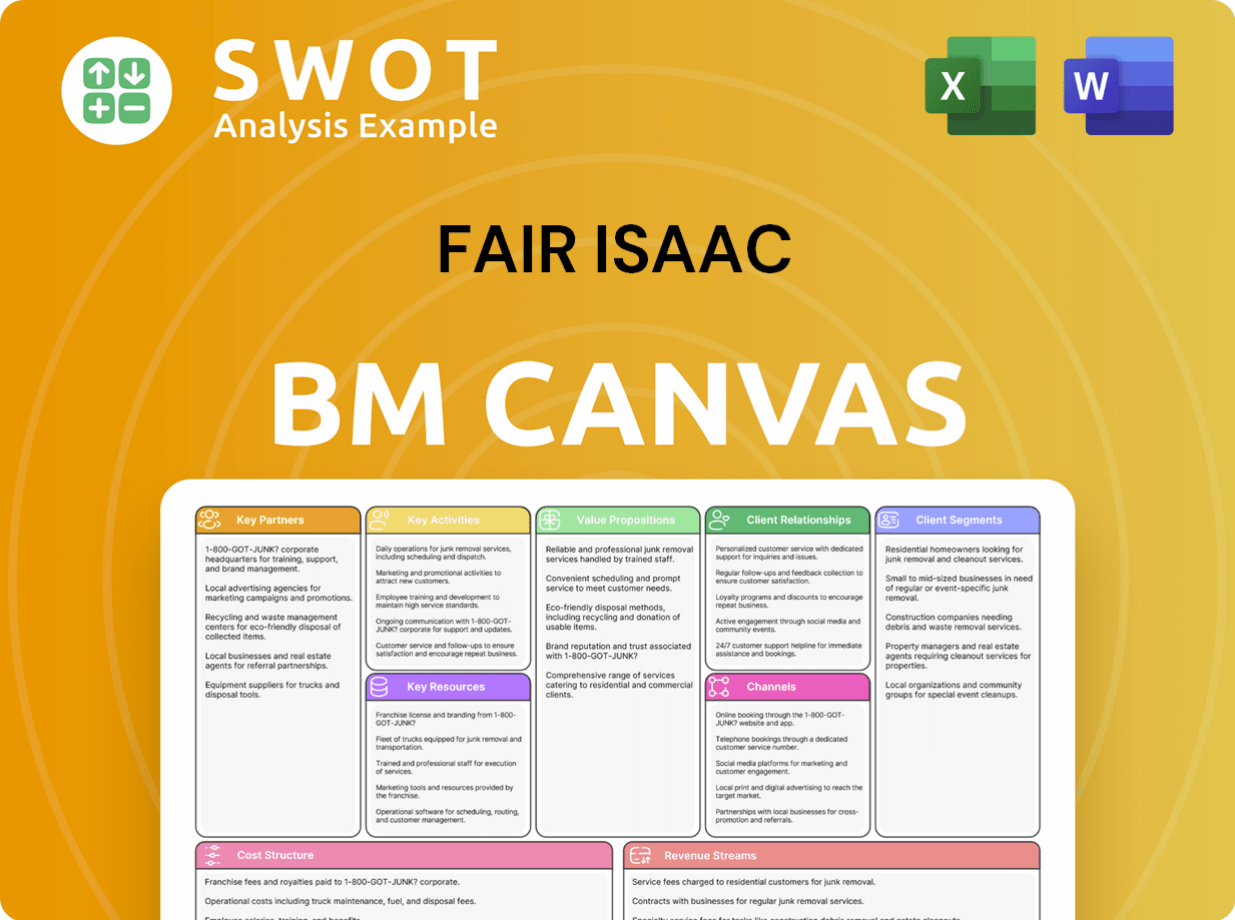
How Does Fair Isaac Win & Keep Customers?
The company utilizes a multi-pronged approach to customer acquisition and retention, primarily focusing on business-to-business (B2B) clients. This strategy involves direct sales efforts, the formation of strategic partnerships, and establishing thought leadership within the industry. Marketing initiatives include participation in industry conferences, hosting webinars, creating digital content marketing campaigns, and placing targeted advertisements in financial and technology publications. Sales tactics are centered on demonstrating the tangible return on investment (ROI) of the company's solutions through the use of case studies and pilot programs, highlighting improvements in decision-making processes, risk reduction, and operational efficiencies.
Given the complex and critical nature of its offerings, customer acquisition often requires a prolonged sales cycle. This process involves in-depth engagement with potential clients to understand their specific needs and to facilitate the integration of the company's solutions into their existing IT infrastructure. Retention strategies emphasize providing exceptional customer service, continuous product innovation, and ongoing support. The company uses customer relationship management (CRM) systems to track client interactions, manage support requests, and identify opportunities for upselling and cross-selling. The company's commitment to innovation has helped retain customers by providing them with cutting-edge tools to stay competitive.
The role of customer data and segmentation is crucial in targeting campaigns, allowing the company to tailor its messaging and product demonstrations to the specific pain points and strategic objectives of different financial institutions or industry verticals. For instance, the company might highlight its fraud detection capabilities to a bank concerned with rising cybercrime rates, while emphasizing its credit lifecycle management tools to a growing fintech lender. Successful acquisition campaigns often stem from the company's reputation as a trusted authority in analytics and risk management, built over decades of industry leadership. To learn more about the company's origins, you can read a Brief History of Fair Isaac.
The company's customer acquisition strategy relies heavily on direct sales and strategic partnerships. These partnerships often involve collaborations with technology providers and financial services firms. This allows the company to expand its market reach and integrate its solutions into existing systems.
The company invests in thought leadership through industry publications, webinars, and conferences. Digital content marketing, including white papers and case studies, is used to educate potential customers. This approach builds trust and positions the company as an expert in the field of analytics and risk management.
A key sales tactic involves demonstrating the tangible return on investment (ROI) of the company’s solutions. This is achieved through case studies and pilot programs. The focus is on showcasing improvements in decision-making, risk reduction, and operational efficiencies.
The company utilizes CRM systems to track client interactions and manage support requests. These systems help identify opportunities for upselling and cross-selling. This approach ensures that customer needs are met and that the company can provide tailored solutions.
The company continuously invests in research and development to keep its products at the forefront of technological advancements. This includes integrating AI and machine learning into its decisioning platforms. This commitment helps retain customers by providing them with cutting-edge tools.
Customer data and segmentation are crucial for targeting campaigns effectively. This allows the company to tailor its messaging and product demonstrations to the specific needs of different financial institutions or industry verticals. This approach ensures that the company can provide targeted solutions.
Fair Isaac Porter's Five Forces Analysis
- Covers All 5 Competitive Forces in Detail
- Structured for Consultants, Students, and Founders
- 100% Editable in Microsoft Word & Excel
- Instant Digital Download – Use Immediately
- Compatible with Mac & PC – Fully Unlocked
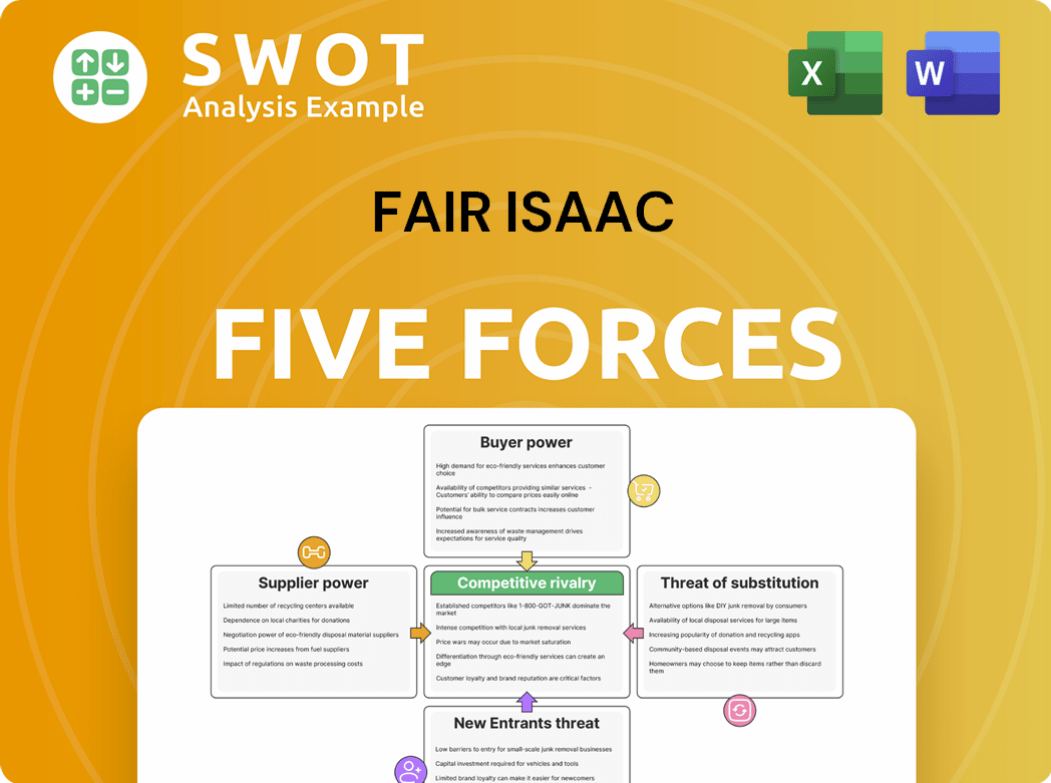
Related Blogs
- What are Mission Vision & Core Values of Fair Isaac Company?
- What is Competitive Landscape of Fair Isaac Company?
- What is Growth Strategy and Future Prospects of Fair Isaac Company?
- How Does Fair Isaac Company Work?
- What is Sales and Marketing Strategy of Fair Isaac Company?
- What is Brief History of Fair Isaac Company?
- Who Owns Fair Isaac Company?
Disclaimer
All information, articles, and product details provided on this website are for general informational and educational purposes only. We do not claim any ownership over, nor do we intend to infringe upon, any trademarks, copyrights, logos, brand names, or other intellectual property mentioned or depicted on this site. Such intellectual property remains the property of its respective owners, and any references here are made solely for identification or informational purposes, without implying any affiliation, endorsement, or partnership.
We make no representations or warranties, express or implied, regarding the accuracy, completeness, or suitability of any content or products presented. Nothing on this website should be construed as legal, tax, investment, financial, medical, or other professional advice. In addition, no part of this site—including articles or product references—constitutes a solicitation, recommendation, endorsement, advertisement, or offer to buy or sell any securities, franchises, or other financial instruments, particularly in jurisdictions where such activity would be unlawful.
All content is of a general nature and may not address the specific circumstances of any individual or entity. It is not a substitute for professional advice or services. Any actions you take based on the information provided here are strictly at your own risk. You accept full responsibility for any decisions or outcomes arising from your use of this website and agree to release us from any liability in connection with your use of, or reliance upon, the content or products found herein.